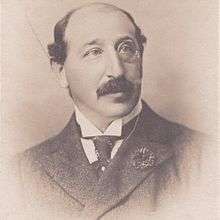Herbert Raphael
Major Sir Herbert Henry Raphael, 1st Baronet (23 December 1859 – 24 September 1924) was a British barrister and Liberal Party politician.[1][2][3]

The second son of Henry Louis Raphael, banker, of Raphaels Bank and his wife and cousin, Henriette née Raphael.[1][4] He was educated in Hanover, Germany and Vevey, Switzerland before attending Trinity Hall, Cambridge where he studied law.[2] He was called to the bar at the Inner Temple in 1883.[1][4] He practiced law for only a few years, choosing to pursue a career in public and political activities.[1][4]
Political career
In 1889 he was elected to the first London County Council as a councillor for St Pancras West. He was a member of the Liberal-backed Progressive Party which controlled the council.[5] He was also a member of the London School Board.[4] He was subsequently a member of the Essex County Council.[1][2][4]
He unsuccessfully contested the Romford constituency as a Liberal candidate in both 1892 and 1897, and St Pancras North in 1900.
He entered the House of Commons at his fourth attempt at the 1906 general election which saw the Liberal Party make numerous gains. He defeated the Conservative incumbent John Gretton to become member of parliament for South Derbyshire.[6] He held the seat until the 1918 general election.[1][4] In 1911 he was created a baronet, of "Cavendish Square in the Metropolitan Borough of St. Marylebone".[7]
Town planner
In the 1890s he was living at Havering Court, Havering Road, Havering-atte-Bower, about 3 miles (4.8 km) north of Romford, in the county of Essex.[8] From 1897, he owned Gidea Hall (demolished 1930)[9] in Essex, which estate consisted of 480 acres (1.9 km2). Later, he lived at Allestree Hall, Derby, where he gave a Memorial Hall to the village.[10]
Raphael began to develop his estate as Gidea Park from 1910 into a garden suburb, now known as Romford Garden Suburb, with two other MPs.[11] The suburb started in 1911 Romford as an exhibition to showcase the work of some of the most eminent architects of the day, such as Clough Williams-Ellis and Charles Robert Ashbee, prominent in the Arts and Crafts Movement. The idea was to demonstrate new ideas in town planning.[12]
War service
Raphael held a commission in the 1st Volunteer Battalion, Essex Regiment at the beginning of the twentieth century.[13] Soon after the outbreak of the First World War, Raphael enlisted as private in the 24th Sportsman's Battalion, Royal Fusiliers.[4] In June 1915 he was granted a commission as a major and raised the 18th (Service) Battalion (Arts & Crafts), the King's Royal Rifle Corps at Gidea Park. Later in the same year he raised the 23rd (Reserve) Battalion of the regiment from the depot companies of the 18th Battalion, and served in turn as second-in-command of each unit.[1][14] Later in the war he was Assistant Provost Marshal at Folkestone, Kent.[2][4]
Art collector and patron
Raphael was active on several committees and a trustee of the National Portrait Gallery.[1][2][4] In 1916, he gave several paintings and portraits to the National Gallery. He also sold several pictures by auction at Christie's on 8 May 1916.[15] He was also a governor of Guy’s Hospital and a justice of the peace for Essex and Derbyshire.[1][2][4]
Family and death
In 1884 Raphael married Rosalie Coster, daughter of William Frederick Coster of Upper Chine, Shanklin, Isle of Wight.[1][2][4] The couple settled at Hockley Sole, Capel-le-Ferne, near Folkestone.[2] Raphael was a keen sportsman, and died suddenly from heart failure while out shooting on his estate in September 1924 aged 64.[4] He had no children, and the baronetcy became extinct on his death.[4]
Notes
- "RAPHAEL, Sir Herbert Henry". Who Was Who. Oxford University Press.
- Walford, Edward (1919). The county families of the United Kingdom; or, Royal manual of the titled and untitled aristocracy of England, Wales, Scotland, and Ireland. London: R Hardwicke. p. 1114.
- Leigh Rayment (2006). Baronets R
- "Obituary. Sir Herbert Raphael". The Times. 26 September 1924. p. 15.
- "The County Councils – London Polls". The Times. 18 January 1889. p. 9.
- Leigh Rayment (). Members of Parliament D Archived 3 October 2011 at the Wayback Machine
- "No. 28509". The London Gazette. 30 June 1911. p. 4833.
- Parishes – Havering-atte-Bower | British History Online
- Romford: Gidea Hall () Archived 20 August 2008 at the Wayback Machine
- "Another former resident of Allestree Hall, Sir Henry Raphael, who represented South Derbyshire for the Liberal Party, gave the Memorial Hall to the village.". Retrieved 24 November 2007. Allestree is the home of Derby University and is near Kedleston, home of the Marquess Curzon
- "Romford then & now : Herbert Raphael". Archived from the original on 6 January 2009. Retrieved 22 June 2008.
- W.R.Powell, ed. (1978). "Romford: Introduction". A History of the County of Essex: Volume 7. pp. 58–66. Retrieved 24 March 2012.
- "No. 27159". The London Gazette. 30 January 1900. p. 605.
- Baker, Chris. "The King's Royal Rifle Corps". The Long, Long Trail The British Army in the Great War. Retrieved 6 November 2018.
- The Fitzwilliam acquired some of his pictures eventually.
External links
- Hansard 1803–2005: contributions in Parliament by Herbert Raphael
- Sir Herbert Raphael, Baronet
| Parliament of the United Kingdom | ||
|---|---|---|
| Preceded by John Gretton |
Member of Parliament for Derbyshire South 1906–1918 |
Succeeded by Holman Gregory |
| Baronetage of the United Kingdom | ||
| New creation | Baronet of Cavendish Square in the Metropolitan Borough of St. Marylebone 1911–1924 |
Extinct |